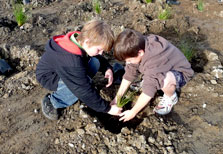Should Be Used When Deciding to Implement a Piece of Public Art for Your Community
Before y'all start a project, it is important to note that certain conditions are needed for community conservation projects to work.
Some key elements for community action are:
- A pressure level for change
- A shared vision
- Capacity for change
- Actionable get-go steps
People must feel a genuine need to better or alter the existing situation. They likewise need time to agree on priorities and must be willing to work with others to do so.
Successful community conservation projects tend to reverberate 3 key principles:
1: The 'planning' principle
Successful community conservation projects are well planned and use inclusive planning and decision-making processes.
Regardless of the particular approach you accept to planning your project, it is always important to:
- Involve everyone. Community conservation projects are constructive where all parties are involved in the planning and controlling at all stages.
- Identify priorities. Rome wasn't congenital in a day and your conservation project won't exist any different! Spend time setting priorities to aid guide your activities.
- Exist flexible. Listen to what people are saying and if necessary, explore other options to get the job done. If a new opportunity comes upward, you may want to have it. While information technology is difficult to plan for flexibility, it is possible.
- Build in means to check your progress. It is important to plan how you'll 'accept stock' of your progress - see monitoring and evaluating progress to help with this task.
For more than ideas nearly planning, see setting your direction.

School children planting
two: The 'partnership' principle
Successful community conservation projects are partnerships that uphold the Treaty of Waitangi principles and place high value on co-functioning, trust and respect betwixt all those involved.
For effective partnerships you need to enable everyone to be involved, whether they are individuals, representatives of groups, agencies or iwi, and jointly concur a 'pale' in the project. This includes a stake in deciding what the projection does and how the project is undertaken, as well as buying of its success or failure.
To build constructive partnerships, yous need to:
- Build and maintain relationships.
- Talk over and agree how the group should operate.
- Establish means for regular communication.
- Deal with conflicts as they arise.
- Use inclusive or 'participatory' controlling when planning and implementing group activities.
For more than ideas about constructive partnerships, see working well as a group.
iii: The 'learning' principle
Successful customs conservation projects create opportunities for enjoyable learning and participation throughout the project, achieving lasting results.
The opportunity to learn is a potent motivator for many people taking part in conservation projects. This includes learning about the conservation issue and its solutions, learning how to work equally a group and learning about each other as individuals and organisations.
Find out what people in your grouping want to learn and what skills they take that can be shared with others. Incorporate talks and demonstrations from people with expertise into regular meetings and events east.thousand. a scientist studying the area, a local landowner with historical noesis or a member of the local iwi who can draw the significance of the site to Maori.
Taking fourth dimension to reflect is very important for learning. In some situations where a group is very focused on 'doing', they ofttimes don't brand time to review their progress. Create time for your group to reverberate on progress, and and so use this information to adjust what you're doing and how. This volition assistance grouping members to learn from the projection (every bit well as checking the project is on track).
Run across monitoring and evaluating progress to assistance with this task.
Stages of a customs conservation project
These principles provide a touchstone for those involved in customs conservation. They are useful to keep in mind when working through the stages typically involved in a community conservation project:
- Getting started
- Setting your direction
- Working well as a grouping
- Monitoring and evaluating progress
Source: https://www.doc.govt.nz/get-involved/run-a-project/community-project-guidelines/project-principles/
0 Response to "Should Be Used When Deciding to Implement a Piece of Public Art for Your Community"
Post a Comment